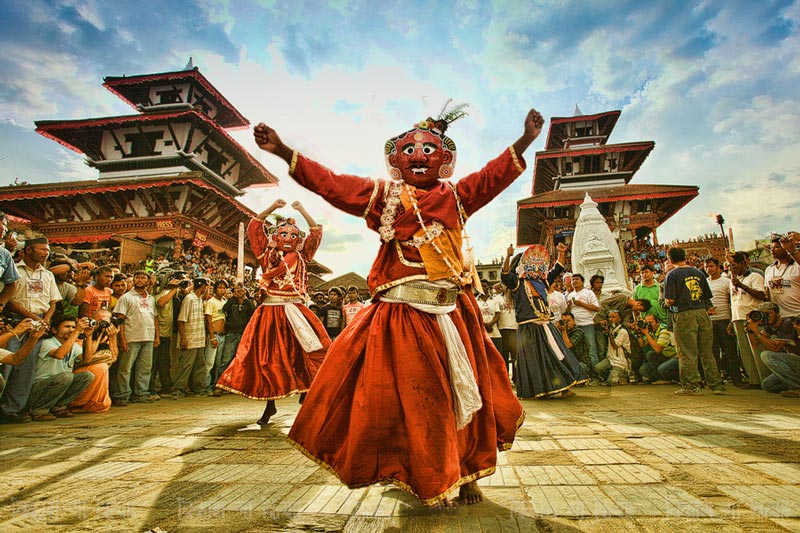Festival as we know it
A Festival is an event or a series of events that is the symbol of celebration, of bringing together people, not only of the same origin but also people from different walks of life. Rich or poor, whatever the background they have or the circumstance they are in when it comes to the festival, it aims to create harmony despite the disparate realities, such as an invoking feeling of belonging as of different colors in the Mandala. It is an intangible heritage based on either a place or a part of the distant past i.e. the history of a race or distinct religion or a culture standing alone or blended with time. Needless to say, it is not only important for those of the native origin but also to those people who are willing to be part of social enjoyment of a unique cultural experience that is not their own just for the sake of celebrating, just for the sake of being in the moment.

In the Nepalese context, Dashain, as well as Tihar, is one of the most important ones (not only for being the longest), as so celebrated by the Hindus and yet it is also enjoyed by people following other religions. It is the time of return, of the sons and daughters from foreign soil where they have toiled for days and nights. And this has become the auspicious period of reunions of family members separated due to economic condition or due to several social reasons. Nonetheless, we celebrate the destined victory of Devi, or the mother against the Asuras/Danavas, a celebration of ever brighter light against the then encroaching darkness, and thus typically tika-jamara is blessed by the elders, with long and happy life for the juniors. And that is in the case of Dashain, whereas in the context of Tihar it is the worship or paying respect to the close companions of humanity who have done and are continuing to do great service. Dog, Crow, and Cow are those who have selflessly helped humanity to move forward and along with there is a ceremony between brother and sister wherein sister wishes to protect her brother from the powerful shadow of Yama, the god of death. Besides that the former is the time of playing kites, that makes the almost empty sky drowned with intense excitement, for there is the tradition of competing to cut the string of other kites, whereas the latter is most famous as the festival of lights as the houses are cleaned, decorated and made beautiful for the special occasions as mentioned above.
Besides Dashain, there are many more festivals like for e.g. Lhosar which refers to the new year. This is basically celebrated by the people following Buddhism and it can be of three kinds Tamu, Sonam, and Gyalpo. Lhosar's celebrated by Gurung, Tamang, and Sherpa communities respectively. As in the above Nepali festivals of Dashain and Tihar, the special cuisines are prepared and consumed in feasts, likewise, traditional clothes are worn including various kinds of beautiful ornaments by women. Another interesting festival to be noted, is the festival of Sakela divided into two parts Ubauli and Udhauli celebrated by the Kirat 'Rai' communities wherein there are special ritual dances and songs performed by traditionally clothed groups of all ages. Former is celebrated as the start of the farming period whereas the latter, as in the harvest period wherein first is a prayer for the Mother nature for the bountiful and healthy crops and the latter is so as to thank her for her providence. (This is in case of time.)
If we talk about places, Indra Jatra in Kathmandu, Bisket Jatra in Bhaktapur, and finally Rato Machindranath Jatra in Lalitpur are the most famous festivals in Nepal or in the capital city. Ghode Jatra, Gai Jatra, Sindur Jatra, and many more are of Newar Community origin and thus it is said that Kathmandu Valley is the city of living heritage where there is, always a never-ending cultural phenomenon. Likewise, Holi is another special festival predominantly celebrated in the Terai or plain areas where different colors are vividly used among friends, families (even strangers) and thus it is called the festival of color or even festival of love. Chhath another festival there, is the festival of sun god that is also widely celebrated wherein there is fasting by women as well as offerings to the sun god in the nearby rivers and most memorable part of the festival is the lighted oil-wick lamps set afloat on those rivers, it is a truly beautiful sight to behold. If we are talking about fasting the more famous among Hindu women is the Teej wherein women fast for the whole day as well as visit the temples for the health of their husbands or for the best one yet to come. They also pass the day by singing beautiful typical songs and dancing in their famous red sari with dazzling ornaments.
(Video description: Every night Chitwan used to have this kind of festival during the season as well as off-season with the influx of Chinese visitors, 2019)
Nonetheless, festivals have not segregated the people but on the other hand, they have united people, transforming these undeniable differences into a unique blend of cultural harmonious unity and thus one Nepali is as unique as another which has to lead to such a rich diversity in our nation that we can be truly proud to be a Nepali.
(PC: nepalsanctuarytreks.com
Comments
Post a Comment